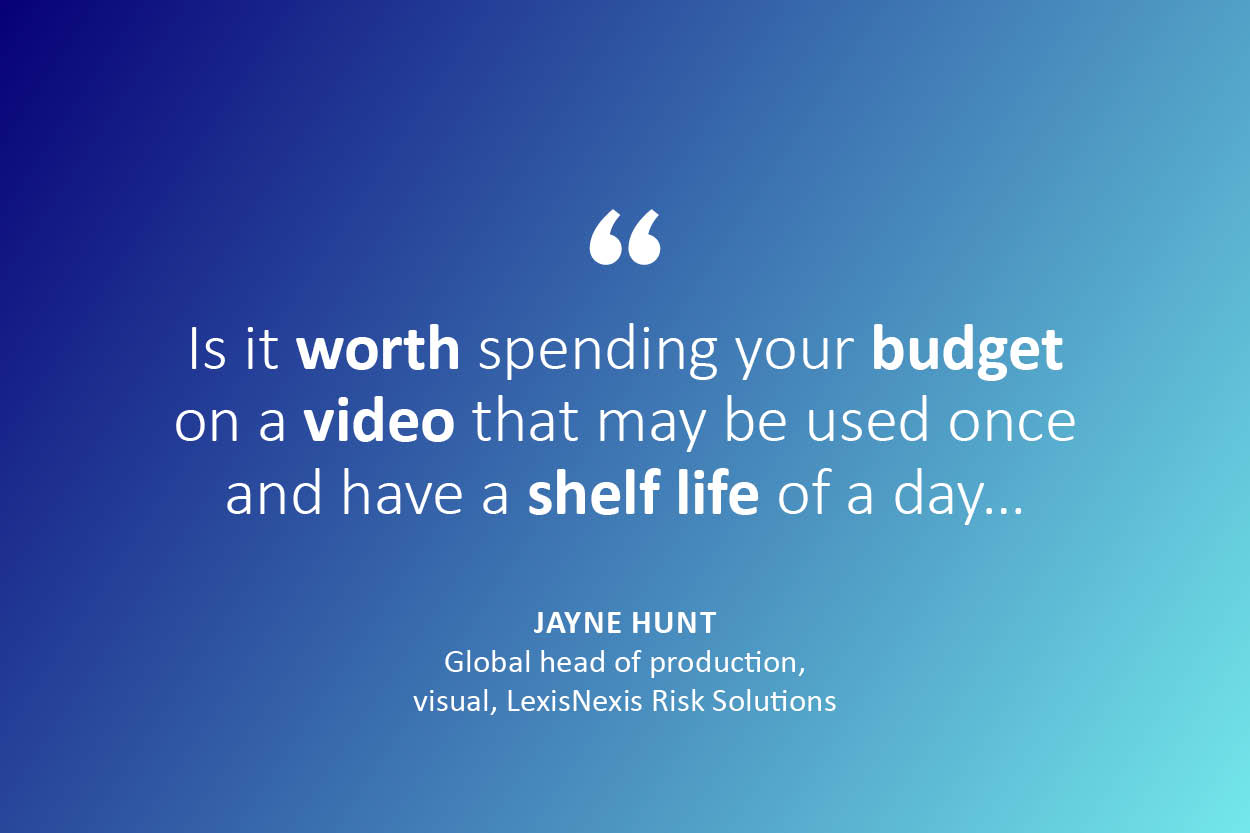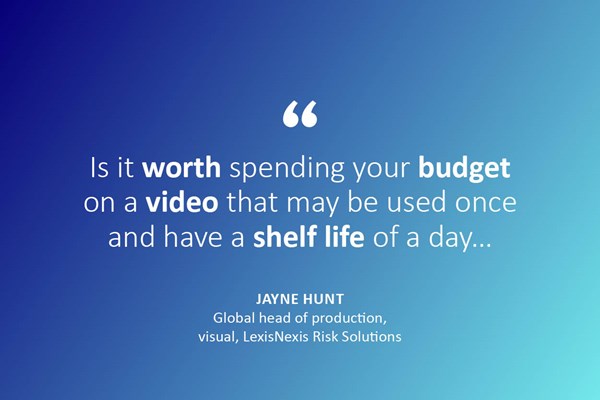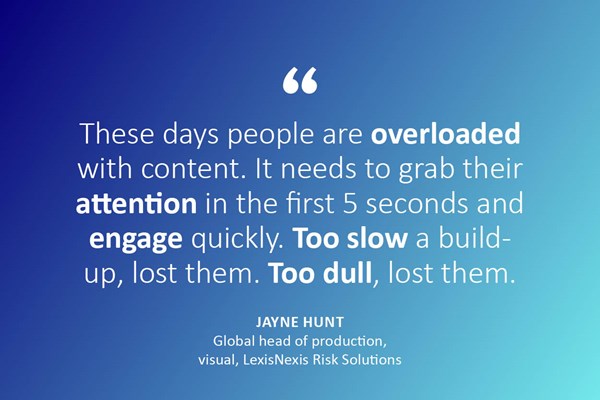What are the essentials of good video marketing?

- 15 August 2023
There’s more to good video marketing than fancy creative and YouTube uploads. CIM spoke to Jayne Hunt, MCIM FRSA and global head of production, visual, at LexisNexis Risk Solutions to discover what can make your video marketing convert your audience to customers.
You might think that video marketing is simple: If people watch and act, it works. If they don’t, it doesn’t. But there’s more to it than just getting a video made and putting it out there.
You need to have a strategy, a purpose, and a way to measure your results.
Not all videos are created equal
It helps if you have a good video in the first place. Video marketing (and we’re including motion graphics or animation in this topic) is a powerful tool to reach and engage your target audience, increase brand awareness, and boost conversions.
But not all videos are created equal. Some videos can captivate, educate, and persuade viewers, while others can bore and annoy them. How many times have you got through a video and not watched to the end? Think why. Small details, like scripting, music, poor audio choice of talent, and a tedious duration can hinder your results. Could you have got your message across in a minute, rather than a 25-minute lecture?
A lot of marketing companies I come across don’t have video strategies, they have Marketing Strategies, and Campaigns, possibly social media posts, and other branding efforts on their ‘to do’ lists, with a list of other milestones for the year, but they don’t consider ‘moving’ content.
Through experience, Video is often an afterthought, when you get to the end of a campaign, or large project and say, “wouldn’t it be nice to have a video” to supplement.
Get your creatives onboard to help deliver solid content cargo
Every creative will tell you that Video content should be considered at the beginning of the process. It may shape, change, or even lead your campaign and it’s a powerful tool if used correctly. But use it wisely and think carefully. Is it worth spending your budget on a video that may be used once and have a shelf life of a day, or have you put lots of facts and figures in it, which may also date it quickly.
There’s lots to think about, use your creatives and ask for their advice. You may be surprised at what they say. Think of it like a boat. The content is the cargo, but without a solid boat that cargo won’t get delivered to your audience successfully.
Although you know your content, experienced creatives know their craft.
Here’s some interesting facts to get you thinking.
- Users spend 88% more time on a website that contains video
- Short videos under 2 minutes get the most engagement
- Video content generates 1200% more shares than images and text combined
- Viewers retain 95% of a message when they watch video, compared to 10% in text
- 86% of businesses use video as a marketing tool
- Marketers who use video grow revenue 49% faster than non-video users
How can you ensure your content is effective?
Here are some questions that you should ask yourself before your team or agency's video marketing even gets off the ground.
What is the goal of your video?
The first question to ask is what you want to achieve with your video. Do you want to raise awareness, educate, entertain, inspire, or persuade? Are you introducing yourself into a new geographical region, promoting a product or service, explaining how to use it, talking to customers, doing thought leadership content, testimonials, brand awareness, or delivering a message from your CEO? Think carefully about ‘WHY’ you need a video and ‘WHAT’ you want it to do?
Depending on your goal, you will need to craft your video message, tone, style, and call to action accordingly. For example, if you want to raise awareness about a social issue, you might want to use a documentary-style video that showcases real stories and facts.
If you want to educate your audience about a product or service, you may want to use an explainer video or short animation that demonstrates how it works and what benefits it offers in a simple way.
If you want to entertain your audience, you could use a humorous or creative video that showcases your brand personality, tone of voice and promote your values.
In fact, you may have a product or service that’s still in development. That’s the beauty of video, you can still create a piece of content that gives people an idea of what’s to come, almost selling the sizzle, not the steak and building anticipation in advance of a launch.
Who is your audience?
The second question to ask is who you are trying to reach with your video.
Who are your ideal customers or clients? What are their demographics, psychographics, pain points, and preferences? What do they like?
There’s been a number of times that I’ve created content and had heavy debates about music. In an old job I even had one client changing the track for a heavy rock music track. The audience is not YOU. The video must appeal to those watching, your potential customers.
But how do they consume video content? Where do they hang out online? By knowing your audience, you can tailor your video content to their needs, interests, and expectations. When do they watch, are you targeting people on their way to work, when home, are they parents, experts, into sport?
Are they also watching on phones, tablets, or computers? This can affect the specifications of your content, sizing and retention. Tone of voice is also key as you need to know if you need to speak to customers in layman’s terms or is the language more specialised and professional.
These days people are overloaded with content. It needs to grab their attention in the first 5 seconds and engage quickly. Too slow a build-up, lost them. Too dull, lost them. Too confusing, they’re now watching something else for light relief.
Also consider inclusivity too when thinking of your audience. You could test your content in random focus groups to eliminate bias and get feedback from diverse perspectives. You can also add captions or subtitles to your video to make it accessible for users with hearing challenges or for example in environments where the sound is off? (Maybe at an event, or a screen in a reception area).
Use clear and simple language, avoid jargon, and slang, and consider where your audience are situated, and what information is feasible to take in when presented on screen.
Provide translations if needed and use diverse and representative images, voices, and stories that reflect your audience. Avoid stereotypes or assumptions.
You may also want to also personalise it a little. If your core base is the US, why use a UK voice over? Put yourself in your customers shoes and think about what would appeal.
For example, if you are targeting millennials, you might want to use a short and catchy video that appeals to their emotions and values. It may release your key messages in a more subtle manner or make reference to things that age group will understand and be attracted to.
If you are targeting professionals, you might want to use a longer and more informative video that showcases your expertise and credibility.
Will your script, and creative content resonate if it’s meant to be delivered in a different country? Is it written correctly for the person speaking it? For it to sound natural the speaker should always take a last look at a script and put their own slight spin on it.
What is the value proposition?
The third question to ask is what value you are offering to your audience with your video.
What problem are you solving, what benefit are you providing, or what opportunity are you creating for them? Why should they watch your video and act?
Your value proposition should be clear, concise, and compelling. It should answer the question "What's in it for me?" for your viewers.
For example, if you are selling a software solution, your value proposition might be "Save time and money by automating your workflows with our software".
If you are promoting a charity event, your value proposition might be "Join us in making a difference for a cause that matters".
How will you measure the success?
The fourth question to ask is how you will track and evaluate the performance of your video.
What metrics will you use to measure the effectiveness of your video marketing? How will you collect and analyse the data? How will you optimize and improve your video strategy based on the results?
It’s also worth thinking about where you’re putting your video content. If it’s hidden on page 12 of a website and your audience can’t find it, then it’s likely to have no clicks. Consider making shorter social media clips as well as your main piece of content so you can maximise your assets and use them on different mediums. Think about a plan to share content widely and how you should roll it out. Does it also need Marketing spend on it?
Choosing the right platform for your video depends on several factors, such as the nature of your business and whether it is B2B or B2C. The demographics and preferences of your target audience. The goals and metrics of your video marketing strategy and the type and quality of your video content.
Some of the most popular video platform options are:
YouTube: The largest video platform, with over 2 billion monthly users. Great for reaching a wide audience, boosting SEO, and monetizing your videos, but also very competitive and saturated.
Facebook: The largest social media platform, with over 2.8 billion monthly users. Great for engaging existing followers, generating leads, and creating live videos. However, it has lower organic reach and retention than YouTube.
Instagram: A visual social media platform, with over 1 billion monthly users. Great for showcasing your brand personality, creating short and catchy videos, and using stories and reels to boost engagement. It does have though limited video length and editing options.
LinkedIn: A professional social media platform, with over 700 million monthly users. Great for reaching B2B audiences, establishing thought leadership, and generating leads, but it does have lower video views and engagement than other platforms.
TikTok: A viral social media platform, with over 689 million monthly users. Great for creating fun and creative videos, reaching younger audiences, and leveraging trends and challenges. However, it has strict video length and format requirements and may not suit every brand image.
Vimeo: A premium video platform, with over 200 million monthly users. Great for hosting high-quality videos, embedding them on your website, and controlling your branding and privacy, but it has lower reach and discoverability than other platforms.
Ultimately, the best platform for your video marketing is the one that matches your audience's behaviour, your brand's voice, and your video's purpose. You can also use multiple platforms to maximize your exposure and results and of course link back to your own website.
Some common metrics that you can use to measure the success of your video marketing:
- Views: The number of times your video was watched
- Watch time: The total amount of time that viewers spent watching your video
- Engagement: The number of likes, comments, shares, and reactions your video generated
- Click-through rate: The percentage of viewers who clicked on a link or button in your video
- Conversion rate: The percentage of viewers who completed a desired action after watching your video, such as signing up for a newsletter, downloading an ebook, or making a purchase
What makes 'good' video marketing?
To sum up, 'good' video marketing is not just about producing high-quality videos. It is also about creating videos that align with your goals, resonate with your audience, and ultimately deliver value, and drive results.
Don't settle for mediocre video marketing. Aim for excellence by planning ahead and creating, and distributing videos that work for you and more importantly your audience.
Hopefully the questions I’ve listed and some of the considerations above will help as a guide to craft your video marketing strategy and ensure your videos are effective, and impactful.
With the right approach, you can unleash the full potential of video and take your marketing to the next level.
You can learn how to create compelling video scripts in different styles with our Social Media Video Scriptwriting training course taught by award winning copywriter, Jonathan Gabay.

Tags:
- 0 views








